Introduction and Spread
The purpose of this publication is to teach interested readers how to identify and distinguish among species of floatinghearts in Florida. Floatinghearts (Nymphoides spp.) are rooted, floating-leaved plants in the Menyanthaceae (buckbean) family. Their genus name is derived from nymph (Greek: water spirit) and -oides (Greek: resembling, similar), i.e., “Nymph-like.” Globally, there are around 50 species of floatinghearts and seven have been found in North America. These seven have all been reported in Florida. Two of these species (bananalily and little floatingheart) are native to North America, and three species (yellow floatingheart, snowflake lily, and crested floatingheart) were introduced through the ornamental water garden market and have escaped cultivation. The introduction pathways of the remaining two species (Gray’s floatingheart and Humboldt’s floatingheart) are unclear, but it is likely they are also water garden escapees or have spread due to “natural” (unaided by humans) range expansion, which was possibly facilitated by flood events or transportation by animals.

Credit: Lyn Gettys, UF/IFAS
Although there are native species of Nymphoides in North America, some of the non-native species have had a significant impact on natural environments. For example, crested floatingheart has jeopardized south Florida’s flood control (canal) systems by obstructing water flow and choking out waterways while displacing native species. Resource managers in South Carolina also struggle to manage non-native floatinghearts in their reservoirs and lakes. In addition to these direct and immediate threats to the ecosystem, hybridization between native species (bananalily and little floatingheart) and between non-native and native species (crested floatingheart and bananalily) has been documented in South Carolina (Harms et al. 2021; Tippery and Les 2013). Hybridization events have the potential to change the gene pool, which could result in greater representation of “aggressive” traits, and could also impact management options.
Description of Species
Nymphoides is a remarkably diverse genus, but member species share some similarities. All exhibit nymphaeid growth form, meaning they are rooted in the substrate, and produce leaves and flowers that float on the surface of the water. These cosmopolitan species differ from one another in growth habitat, flower appearance, structure, and reproductive strategy. Molecular work and ancestral reconstruction have shown that this genus has evolved independently at least twice through time. All of the seven species of floatingheart that have been reported in North American water bodies have multiple long petioles (leaf stalks) that each bear a single leaf. Most of the seven species reproduce through vegetative means, although some produce viable seeds as well.
Native Floatinghearts
Bananalily (N. aquatica) is found throughout the eastern and central United States. The leaves are oval to kidney-shaped, with a dark-green upper surface and a purple corky underside that often has prominent veins. Flowers range from 1/3 to 3/4 inch wide and have five white, smooth petals with a papery margin and a yellow center.
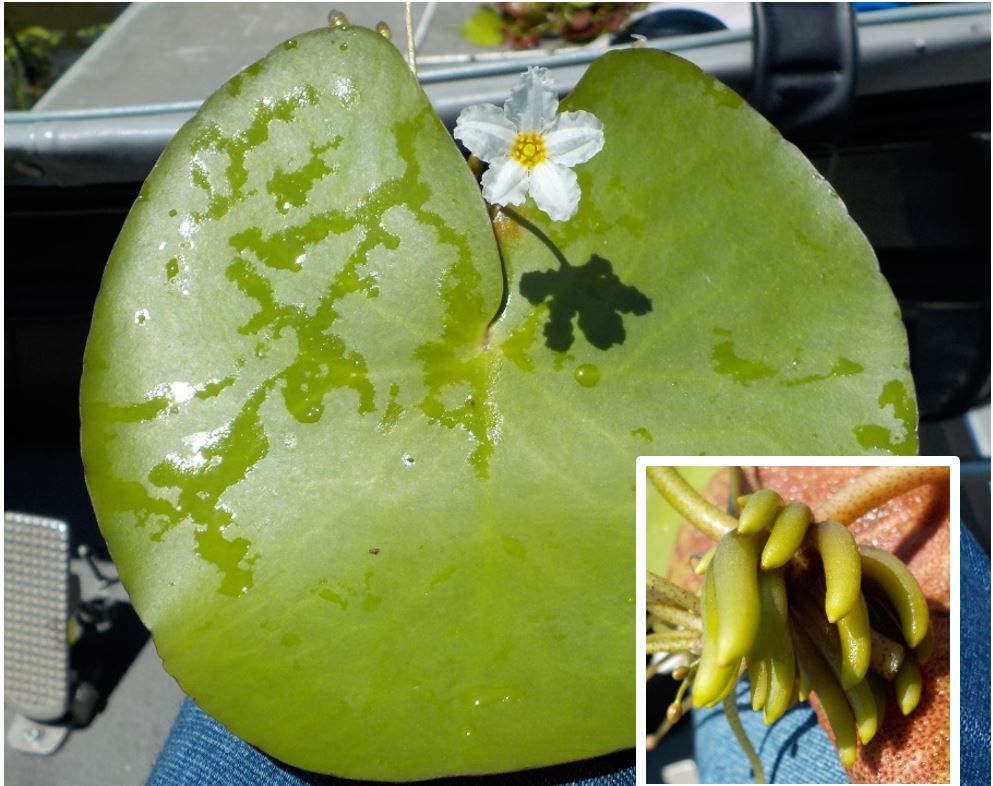
Credit: Lyn Gettys, UF/IFAS
Little floatingheart (N. cordata) is found throughout the eastern United States and Canada and has heart-shaped to oval leaves that are often variegated with a reddish-purple upper surface and an underside that is mostly smooth (like fine sandpaper). At only 1/5 to 2/5 inch wide, the flowers of little floatingheart are smaller than those of bananalily, but are otherwise similar in appearance. The smooth, flat-petaled white flowers of bananalily and little floatingheart are distinctive and are characteristic of native species of Nymphoides; as outlined below, the flowers of non-native species are fringed, crested, or yellow. The primary reproduction method for both species is the production of ramets, which are rhizome-like clusters that form at the base of the leaf. These ramets break off and float away to become a new plant.
Non-Native Floatinghearts
Crested floatingheart (N. cristata) is native to southeastern Asia. Leaves are up to 8 inches long, 6 inches wide, and heart-shaped; the upper surface of the leaf is green, usually with a red margin, and the underside is smooth and reddish. This species produces white five-petaled flowers that are up to 1 inch across and have a membranous margin and a crest or ridge running down the center of each petal. Similar to the native floatinghearts, the primary method of reproduction for crested floatingheart is via spiky ramets, which float through the water column and eventually sink to the bottom where they can root and sprout to form new plants. A single founder plant can produce as many as 500 ramets over six months, and 40% of these are likely to sprout, resulting in around 200 new plants. If those plants are as productive as the founder plant, a population could expand from the original single plant to more than 20,000 plants in under two years (Gettys et al. 2017). Seed production by crested floatingheart is not well understood, but this species has reportedly hybridized with bananalily (Harms et al. 2021) and therefore seems able to reproduce via seeds.
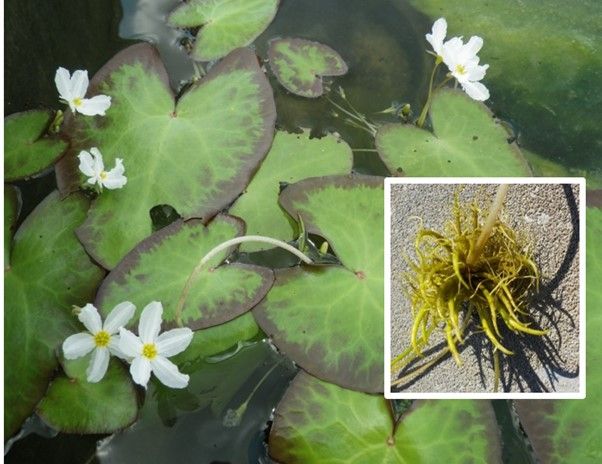
Credit: Lyn Gettys, UF/IFAS
Due to its attractive appearance, crested floatingheart has long been prized as a water garden ornamental. The species was first discovered in the wild in 1996, when it apparently escaped cultivation in southwest Florida, invaded the lake of a residential subdivision, and quickly spread throughout the drainage canals. By 2001, crested floatingheart had spread north to Sarasota and east to Palm Beach County. It is now broadly distributed throughout the state, spurring the plant’s addition to the Florida Noxious Weeds List in 2014. The species was found in South Carolina’s Santee Cooper system in 2006 and continues to be one of the most vexing problems for resource managers there. In addition to Florida and South Carolina, active invasions of crested floatingheart exist throughout the southeastern United States (eastern Texas, Louisiana, North Carolina, and possibly Mississippi). For more information, see https://assessment.ifas.ufl.edu/assessments/nymphoides-cristata/.
Yellow floatingheart (N. peltata) is native to Central Europe and Asia Minor, where it occurs in temperate and subtropical climates. Leaves are oval to heart-shaped with a wavy or scalloped margin and are attached to the stems in an opposite manner. Leaf size and shape are dependent upon season; plants produce small leaves in winter, and spring to early summer bring small folded leaves that open more when temperature and daylight increase. The upper surface of the leaves is green to yellow-green and the underside may be maroon or purple. A bright-yellow, five-petaled flower that measures up to 2 inches across is produced at each leaf. The flower has a broad membranous margin that is wavy to ruffled, which creates an irregular fringe along the edge of each petal. Yellow floatingheart does not seem to produce ramets, but instead produces stolons that grow through the water column and along the bottom of slow-moving water bodies. Stolon fragments produce adventitious roots and form young plants with a single leaf, but the primary mode of reproduction for yellow floatingheart appears to be seed production. Each flower produces a seed capsule that splits at the end of the growing season and releases many smooth seeds with winged margins. The seeds float until a disturbance causes them to break the water surface; they then sink, remain dormant through the winter and sprout in the spring.
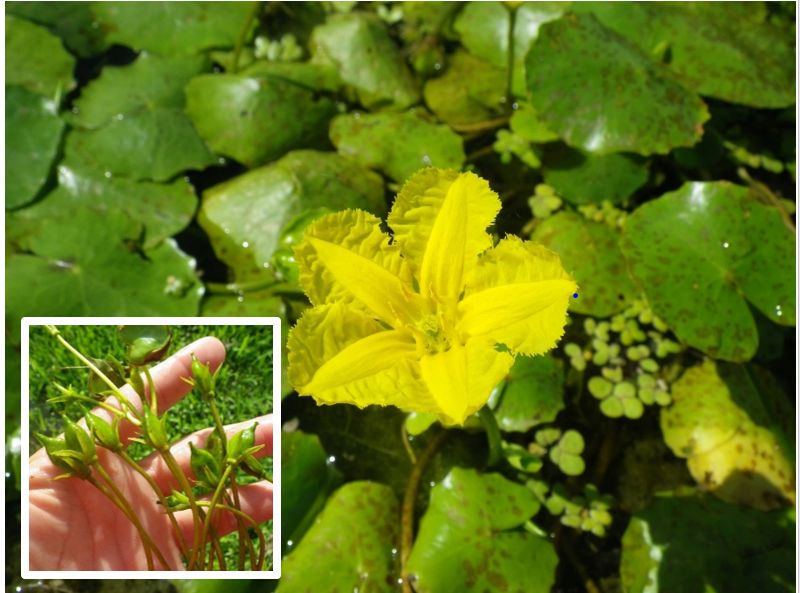
Credit: Lyn Gettys, UF/IFAS
Yellow floatingheart is cosmopolitan in distribution and is found throughout much of the world. The species may be spread by escaping cultivation or by hitchhiking on birds or aquatic animals. It is invasive in the United States (where it has been reported in 34 states) and New Zealand, but threatened in Japan. Yellow floatingheart was first documented in 1882 in New York City’s Central Park, where it was grown in a terrace pond, and has been marketed as an ornamental in the water garden industry since 1891. By 1930, it was found out of cultivation in the Pacific Northwest and was reported in eastern Washington and Oregon. Similar to crested floatingheart, yellow floatingheart was added to the Florida Noxious Weeds List in 2014. For more information, see https://assessment.ifas.ufl.edu/assessments/nymphoides-peltata/.
Water snowflake (N. indica) is native to tropical Asia and Africa. The thick, fleshy, round leaves measure up to 7 inches across and are bright green on the upper and lower surfaces. Each flower has six to twelve white, densely fringed petals that are covered with hairs, and multiple flowers may be associated with a single leaf. Water snowflake reproduces mainly via seed but can propagate effectively through vegetative means such as stem fragments.
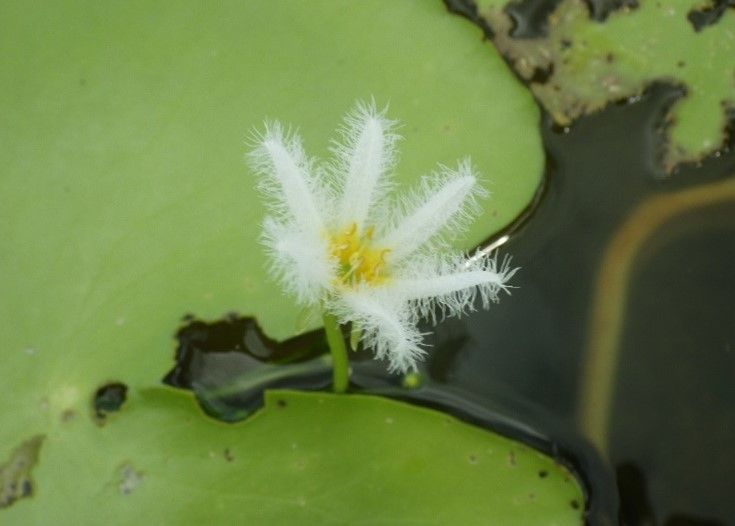
Credit: Lyn Gettys, UF/IFAS
Water snowflake was introduced to Florida either intentionally or as an accidental escape from the water garden and aquarium industry. Water snowflake has been reported in several counties in Florida, although most of those specimens have now been identified as Humboldt’s floatingheart through molecular genetics. The only other report of non-cultivated water snowflake in the United States is from Hawaii, but the status of that infestation is unknown. Although this species is not native, it is not considered invasive. See https://assessment.ifas.ufl.edu/assessments/nymphoides-indica/ for more information.
Floatinghearts of Uncertain Origin
Gray’s floatingheart (N. grayana), native to Cuba and the Bahamas, was recently identified in Florida. The USDA classifies the species as non-native. Wunderlin et al. (2022) state the plant is probably a water garden escape in Florida, where the species has been reported in three counties. It is likely that the species has been in Florida for a number of years but was misidentified as a color variant of water snowflake. Gray’s floatingheart has arrowhead- or heart-shaped leaves that are dull green on the upper surface and purplish on the underside with overlapping lobes. The flowers have bright-yellow petals with densely fringed margins. There is a lack of information about this species, so the reproductive ecology and the true native range of Gray’s floatingheart are uncertain.
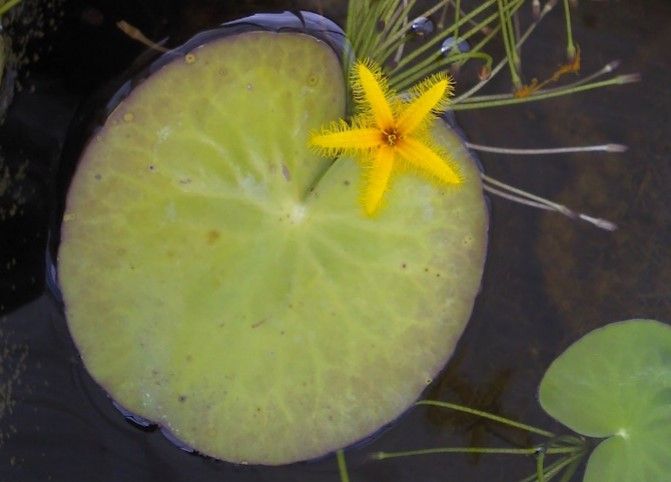
Credit: Lyn Gettys, UF/IFAS
Humboldt’s floatingheart (N. humboldtiana) has also been reported in Florida (Middleton et al. 2018). The species is native to the Caribbean and Mexico and is classified as non-native. Humboldt’s floatingheart has oval to heart-shaped leaves that are bright green (or sometimes mottled) on the upper surface and underside with indistinct veins. The white flowers are very similar to those of water snowflake but usually have five petals. Humboldt’s floatingheart reproduces via seeds that lack tubercles (small, wart-like projections). This characteristic can be useful to distinguish this species from water snowflake, which produces seeds that do have tubercles. Humboldt’s floatingheart has been reported in two counties in Florida and one county in Texas. As with Gray’s floatingheart, it is likely that Humboldt’s floatingheart has been in Florida for a number of years but was misidentified as a variant of water snowflake.
Problems Associated with Nymphoides
Non-native species of Nymphoides such as crested and yellow floatinghearts have the potential to interfere with navigation, recreation, flood control, and other water-based activities by clogging the aquatic system with dense plant material. These invasive floatinghearts species cause ecological problems as well. Their accelerated reproduction and ability to create canopy-forming monocultures on the water surface allow these species to outcompete and displace native floatinghearts and other desirable native species, thus reducing habitat quality.
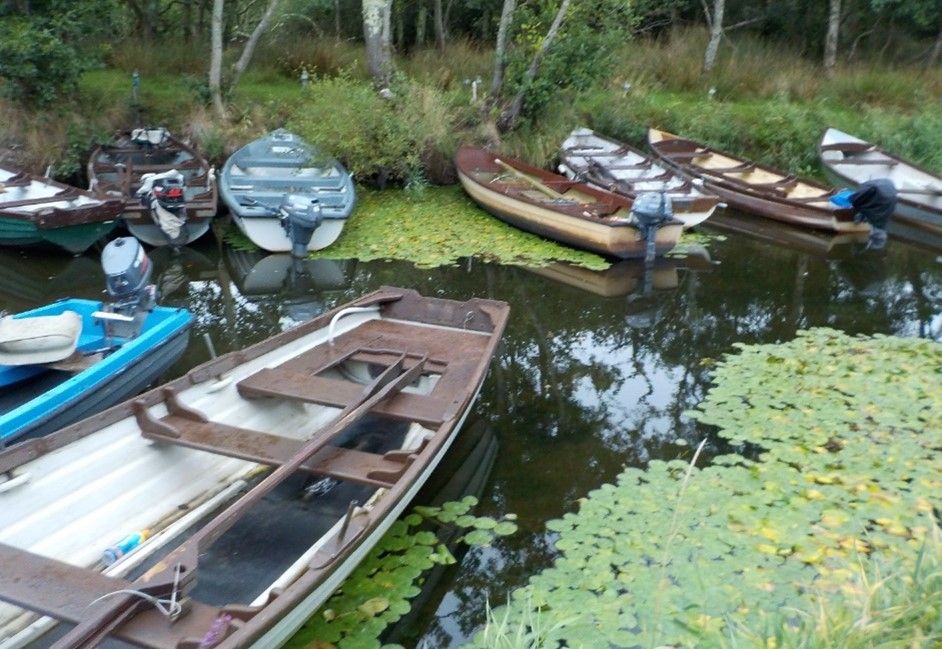
Credit: Lyn Gettys, UF/IFAS
Management Options
The varied reproductive strategies (ramets, seeds, and fragmentation) of invasive floatinghearts are problematic for resource managers and may limit the effectiveness of some management techniques. As with many invasive species, the best method to prevent these plants from causing ecological damage and interfering with human uses of an aquatic resource is to prevent the species from entering the water body. Some states do prohibit the sale and transport of certain species of floatingheart, but existing populations still manage to increase their range and colonize new bodies of water.
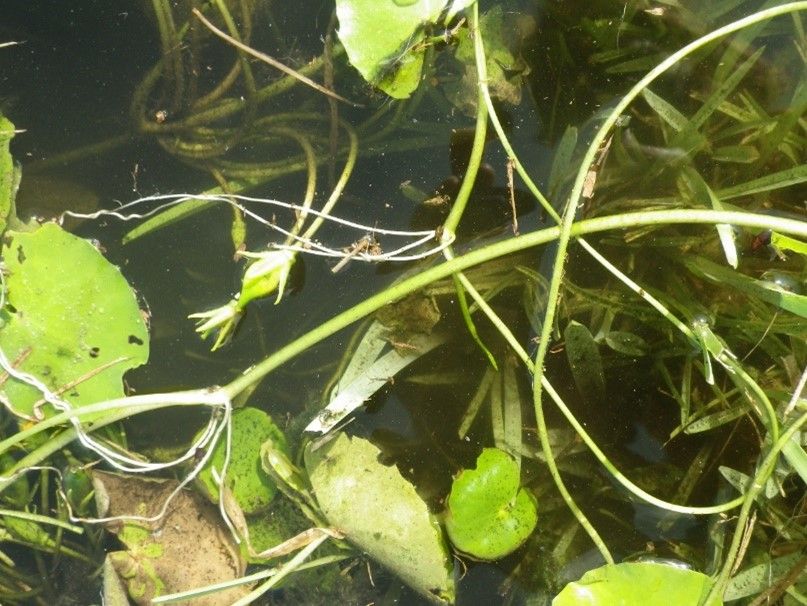
Credit: Lyn Gettys, UF/IFAS
Physical or mechanical control measures such as hand removal or mechanical harvesters are not practical for managing crested and yellow floatinghearts because both species can reproduce via stem and leaf fragments and are thought to have the capacity to regrow from root crowns that remain in the soil after harvesting plant material in the water column. In addition, crested floatingheart produces many ramets and yellow floatingheart produces copious seeds, both of which are left behind after harvesting and can quickly sprout to repopulate the system. Cultural control methods such as dewatering or drawdowns may have some utility for crested floatingheart management, as ramet viability is significantly decreased after 24 hours of desiccation. However, the seeds of some floatingheart species are induced to germinate by drawdown, which can result in significant infestations once water levels are returned to their normal state. Ramets that are buried under as little as 4 cm of soil rarely sprout, so benthic barriers may reduce the number or density of populations that are derived from ramets. No floatingheart-specific biocontrol agents have been identified for these species, although the aquatic larvae of a native generalist moth reportedly consume native floatinghearts.
Another tool for floatingheart management is chemical control, or the use of herbicides. Although both foliar and water-column treatments can be utilized to control large infestations, water-column treatments tend to be more effective. Contact herbicides such as diquat and endothall and systemic herbicides such as imazamox, imazapyr, and auxins (2,4-D, triclopyr, and florpyrauxifen-benzyl) have been used for management of floatinghearts with varying levels of success. As with other floating-leaved species, herbicide efficacy is influenced by environmental conditions such as currents and wave action (Markovich et al. 2020).

Credit: Lyn Gettys, UF/IFAS
Summary
The genus Nymphoides is quite diverse, and Florida hosts both native and non-native species. Non-native species—especially crested and yellow floatinghearts—can have serious effects on the environment by outcompeting and hybridizing with native floatinghearts and other desirable native species and can interfere with human uses of invaded waters by clogging the water column and inhibiting flow. Early detection and rapid response are the least expensive and most effective means to prevent non-native floatinghearts from expanding into uninvaded aquatic systems. Aggressive management should be employed in areas where these species already occur to avoid expansion of existing populations and to reduce the likelihood of new introductions to connected waterways. The use of most control methods is limited due to the multiple reproductive strategies utilized by non-native floatinghearts, but several chemical control tools can be used to manage populations of invasive members of the genus Nymphoides.
References
Gettys, L. A., C. J. Della Torre III, K. M. Thayer, and I. J. Markovich. 2017. “Asexual Reproduction and Ramet Sprouting of Crested Floatingheart (Nymphoides cristata).” Journal of Aquatic Plant Management 55:83–88.
Harms, N. E., R. A. Thum, L. A. Gettys, I. J. Markovich, A. French, L. Simantel, and R. Richardson. 2021. “Hybridization between Native and Invasive Nymphoides Species in the United States.” Biological Invasions 23:3003–3011. https://doi.org/10.1007/s10530-021-02558-9
Markovich, I. J., J. W. Sigmon, and L. A. Gettys. 2020. “2.9: Floatinghearts.” In Biology and Control of Aquatic Plants: A Best Management Practices Handbook, 4th Edition, edited by L. A. Gettys, W. T. Haller, and D. G. Petty. 59–64. Marietta, GA: Aquatic Ecosystem Restoration Foundation.
Middleton, B. A., E. Anemaet, T. E. Quirk, and N. P. Tippery. 2018. “Nymphoides humboldtiana (Menyanthaceae) in Florida (USA) Verified by DNA Data.” Journal of the Botanical Research Institute of Texas 12(1): 257–263.
Tippery, N. P., and D. H. Les. 2013. “Hybridization and Systematics of Dioecious North American Nymphoides (N. aquatica and N. cordata; Menyanthaceae).” Aquatic Botany 104:127–137. https://doi.org/10.1016/j.aquabot.2012.08.003
Wunderlin, R. P., B. F. Hansen, A. R. Franck, and F. B. Essig. 2022. “Atlas of Florida Plants (http://florida.plantatlas.usf.edu/).” [S. M. Landry and K. N. Campbell (application development), USF Water Institute.] Institute for Systematic Botany, University of South Florida, Tampa.